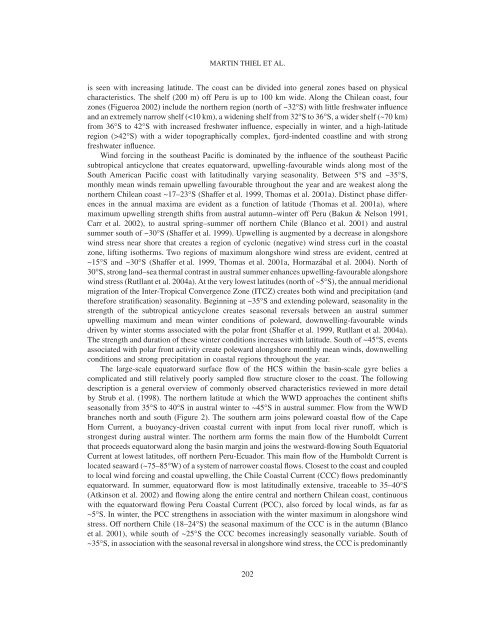the humboldt current system of northern and central chile - figema
the humboldt current system of northern and central chile - figema
the humboldt current system of northern and central chile - figema
Create successful ePaper yourself
Turn your PDF publications into a flip-book with our unique Google optimized e-Paper software.
MARTIN THIEL ET AL.is seen with increasing latitude. The coast can be divided into general zones based on physicalcharacteristics. The shelf (200 m) <strong>of</strong>f Peru is up to 100 km wide. Along <strong>the</strong> Chilean coast, fourzones (Figueroa 2002) include <strong>the</strong> nor<strong>the</strong>rn region (north <strong>of</strong> ~32°S) with little freshwater influence<strong>and</strong> an extremely narrow shelf (42°S) with a wider topographically complex, fjord-indented coastline <strong>and</strong> with strongfreshwater influence.Wind forcing in <strong>the</strong> sou<strong>the</strong>ast Pacific is dominated by <strong>the</strong> influence <strong>of</strong> <strong>the</strong> sou<strong>the</strong>ast Pacificsubtropical anticyclone that creates equatorward, upwelling-favourable winds along most <strong>of</strong> <strong>the</strong>South American Pacific coast with latitudinally varying seasonality. Between 5°S <strong>and</strong> ~35°S,monthly mean winds remain upwelling favourable throughout <strong>the</strong> year <strong>and</strong> are weakest along <strong>the</strong>nor<strong>the</strong>rn Chilean coast ~17–23°S (Shaffer et al. 1999, Thomas et al. 2001a). Distinct phase differencesin <strong>the</strong> annual maxima are evident as a function <strong>of</strong> latitude (Thomas et al. 2001a), wheremaximum upwelling strength shifts from austral autumn–winter <strong>of</strong>f Peru (Bakun & Nelson 1991,Carr et al. 2002), to austral spring–summer <strong>of</strong>f nor<strong>the</strong>rn Chile (Blanco et al. 2001) <strong>and</strong> australsummer south <strong>of</strong> ~30°S (Shaffer et al. 1999). Upwelling is augmented by a decrease in alongshorewind stress near shore that creates a region <strong>of</strong> cyclonic (negative) wind stress curl in <strong>the</strong> coastalzone, lifting iso<strong>the</strong>rms. Two regions <strong>of</strong> maximum alongshore wind stress are evident, centred at~15°S <strong>and</strong> ~30°S (Shaffer et al. 1999, Thomas et al. 2001a, Hormazábal et al. 2004). North <strong>of</strong>30°S, strong l<strong>and</strong>–sea <strong>the</strong>rmal contrast in austral summer enhances upwelling-favourable alongshorewind stress (Rutllant et al. 2004a). At <strong>the</strong> very lowest latitudes (north <strong>of</strong> ~5°S), <strong>the</strong> annual meridionalmigration <strong>of</strong> <strong>the</strong> Inter-Tropical Convergence Zone (ITCZ) creates both wind <strong>and</strong> precipitation (<strong>and</strong><strong>the</strong>refore stratification) seasonality. Beginning at ~35°S <strong>and</strong> extending poleward, seasonality in <strong>the</strong>strength <strong>of</strong> <strong>the</strong> subtropical anticyclone creates seasonal reversals between an austral summerupwelling maximum <strong>and</strong> mean winter conditions <strong>of</strong> poleward, downwelling-favourable windsdriven by winter storms associated with <strong>the</strong> polar front (Shaffer et al. 1999, Rutllant et al. 2004a).The strength <strong>and</strong> duration <strong>of</strong> <strong>the</strong>se winter conditions increases with latitude. South <strong>of</strong> ~45°S, eventsassociated with polar front activity create poleward alongshore monthly mean winds, downwellingconditions <strong>and</strong> strong precipitation in coastal regions throughout <strong>the</strong> year.The large-scale equatorward surface flow <strong>of</strong> <strong>the</strong> HCS within <strong>the</strong> basin-scale gyre belies acomplicated <strong>and</strong> still relatively poorly sampled flow structure closer to <strong>the</strong> coast. The followingdescription is a general overview <strong>of</strong> commonly observed characteristics reviewed in more detailby Strub et al. (1998). The nor<strong>the</strong>rn latitude at which <strong>the</strong> WWD approaches <strong>the</strong> continent shiftsseasonally from 35°S to 40°S in austral winter to ~45°S in austral summer. Flow from <strong>the</strong> WWDbranches north <strong>and</strong> south (Figure 2). The sou<strong>the</strong>rn arm joins poleward coastal flow <strong>of</strong> <strong>the</strong> CapeHorn Current, a buoyancy-driven coastal <strong>current</strong> with input from local river run<strong>of</strong>f, which isstrongest during austral winter. The nor<strong>the</strong>rn arm forms <strong>the</strong> main flow <strong>of</strong> <strong>the</strong> Humboldt Currentthat proceeds equatorward along <strong>the</strong> basin margin <strong>and</strong> joins <strong>the</strong> westward-flowing South EquatorialCurrent at lowest latitudes, <strong>of</strong>f nor<strong>the</strong>rn Peru-Ecuador. This main flow <strong>of</strong> <strong>the</strong> Humboldt Current islocated seaward (~75–85°W) <strong>of</strong> a <strong>system</strong> <strong>of</strong> narrower coastal flows. Closest to <strong>the</strong> coast <strong>and</strong> coupledto local wind forcing <strong>and</strong> coastal upwelling, <strong>the</strong> Chile Coastal Current (CCC) flows predominantlyequatorward. In summer, equatorward flow is most latitudinally extensive, traceable to 35–40°S(Atkinson et al. 2002) <strong>and</strong> flowing along <strong>the</strong> entire <strong>central</strong> <strong>and</strong> nor<strong>the</strong>rn Chilean coast, continuouswith <strong>the</strong> equatorward flowing Peru Coastal Current (PCC), also forced by local winds, as far as~5°S. In winter, <strong>the</strong> PCC streng<strong>the</strong>ns in association with <strong>the</strong> winter maximum in alongshore windstress. Off nor<strong>the</strong>rn Chile (18–24°S) <strong>the</strong> seasonal maximum <strong>of</strong> <strong>the</strong> CCC is in <strong>the</strong> autumn (Blancoet al. 2001), while south <strong>of</strong> ~25°S <strong>the</strong> CCC becomes increasingly seasonally variable. South <strong>of</strong>~35°S, in association with <strong>the</strong> seasonal reversal in alongshore wind stress, <strong>the</strong> CCC is predominantly202










